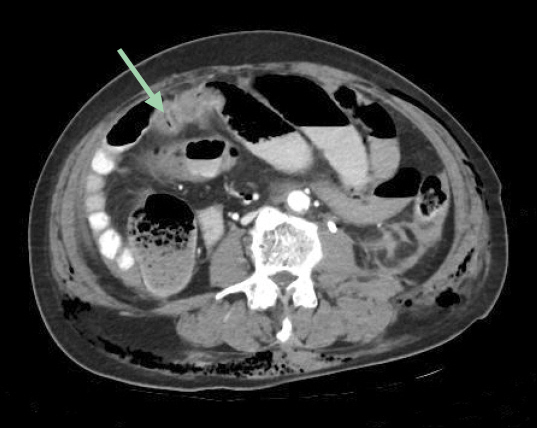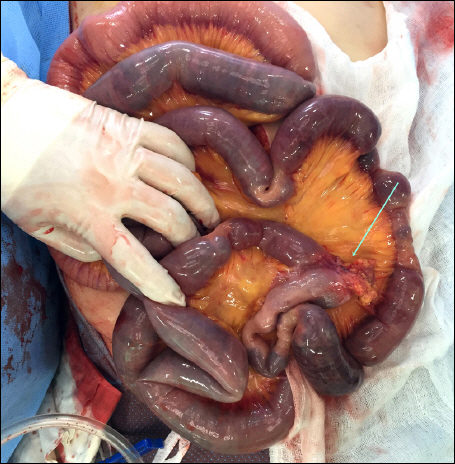Introduction
Pneumatosis intestinalis is an imaging phenomenon representing the presence of gas in the bowel wall. Low blood pressure and low blood flow led to the incarceration of the bowel. During reperfusion, the incarcerated bowel became edematous and caused tissue damage. The gas-producing bacteria had entered the bowel wall through the break point of intestinal integrity. Bowel and bladder injuries have been observed in less than 1% of these falling injuries [1]. We experienced this Pneumatosis intestinalis after falling down trauma. This article focuses on symptoms, diagnosis and treatment of this life-threatening condition based on a Case Report and review of the literature.
Case Report
A 63-year-old female slipped and fell from an approximately 40 m height from her apartment. She had a hysterectomy due to myoma 24 years prior, and took medication for hypertension. She did not have any signs or symptoms of an acute surgical abdomen or abnormal digestive function. Upon arriving at our hospital, her systolic blood pressure was less than 60 mmHg, and her pulse rate was 130 beats/min. There were many contusions on her back, but no definite contusion on her abdomen. After resuscitation, the computed tomography (CT) scan revealed a splenic rupture and multiple bilateral rear rib fractures, but there was no definite injury of her abdominal solid organs or intestine other than the spleen. The splenic rupture was treated with angioembolization. After the angioembolization, her blood pressure returned to 120/80 mmHg.
Six hours after the angioembolization, her blood pressure had decreased to 70/60 mmHg, and her hemoglobin levels declined from 12.2 to 7.5 g/dl. On physical examination, her abdomen was distended. A follow-up CT scan showed a completely infarcted splenic artery. The small intestine was also swollen, and there was an air shadow in the small intestine (Fig. 1). An exploratory laparotomy was planned for the identification of the bowel injury. A median laparotomy was performed, and the abdominal cavity was examined. The small intestine adhered to the abdominal wall, and the small intestine had herniated through adhesion bands created due to the previous operation. After adhesiolysis, there was no definite perforation or contusion on the small intestine, but the small intestine was incarcerated from 100 cm below the Treitz ligament to 10 cm above the ileocecal valve (Fig. 2). There was only one point of fibrotic adhesion to the abdominal wall. The incarcerated intestine was resected, and the remaining parts of the small intestine were anastomosed in an end-to-end fashion (jejuno-colic anastomosis). The pathologic findings revealed a hemorrhagic infarction of the small intestine with the congestion of submucosal blood vessels and multiple foci of necrotic changes with thin walls. After surgery, she gradually tolerated oral feedings and was discharged from the hospital without any complications.
Discussion
We have reported on a very rare case of an ischemia-reperfusion injury of the small intestine (pneumatosis intestinalis) due to blunt trauma. Few patients who have fallen from heights have intra- abdominal injuries, with the majority requiring operative or angioembolization management for injuries to solid organs. However, bowel and bladder injuries have been observed in less than 1% of these falling injuries [1]. We thought the splenic injury caused the low blood pressure, which could lead to an ischemic intestine injury. After a successful angioembolization, the restored blood pressure levels could cause a reperfusion injury in the strangulated intestine due to the previous operative fibrosis in the abdominal cavity. It took around 10 hours to find this pneumatosis intestinalis on a CT scan. Otherwise, the plain film radiographs of the chest and abdomen at the time of the initial presentation were normal.
Pneumatosis intestinalis is an imaging phenomenon representing the presence of gas in the bowel wall. The suggested mechanism of pneumatosis intestinalis is secondary to the gas-producing bacteria that enter the bowel wall when the circulation is compromised [2]. This gas cannot transgress all three layers of the bowel wall, and pneumoperitoneum is not consistently present [3]. Intra-abdominal adhesions are the first cause of small bowel obstructions, strangulation, and ischemia [4]. In this case, the patient had no specific signs or symptoms of an internal hernia after her hysterectomy. The splenic injury caused the low blood pressure, and this low blood pressure may have led to an ischemic injury of the intestine (pneumatosis intestinalis).
Shock, vascular surgery, and small bowel transplantation are clinical conditions that are associated with mesenteric ischemia- reperfusion injury [4]. The interruption of the blood supply results in ischemic injury that rapidly damages metabolically active tissues [5]. Paradoxically, restoration of blood flow to the ischemic tissue initiates a cascade of events that may lead to additional cellular injury known as reperfusion injury [6]. Ischemia-reperfusion injury can result in tissue damage caused by the generation of oxygen free radicals, neutrophilic infiltration, and mucosal apoptosis [5]. Among all internal organs, the intestine is probably the most sensitive to ischemia-reperfusion injury [5]. The reduction of blood supply results in damage to the intestinal mucosa [6]. Enterocytes that are located at the tips of the villi are very sensitive to the effects of ischemia [6]. Gas-producing bacteria enter the bowel wall when the circulation is compromised [2]. Therefore, pneumatosis intestinalis can occur during these circumstances. Although there was already an internal hernia, she had no signs or symptoms due to the maintenance of essential blood flow to the herniated bowel in this case. However, low blood pressure and low blood flow led to the incarceration of the herniated bowel. During reperfusion, the incarcerated bowel became edematous and caused tissue damage. The gas-producing bacteria had entered the bowel wall through the break point of intestinal integrity. The pathologic finding of a hemorrhagic infarction of the small intestine with congestion of the submucosal blood vessels and multiple foci of necrotic changes and thin walls might support the diagnosis of ischemia-reperfusion injury. Pneumatosis intestinalis in the patient with blunt abdominal trauma increase the clinicianŌĆÖs concerns about the occurrence of rapidly fatal, but potentially correctable conditions, such as bowel ischemia and/or necrosis [3]. Subsequently, in those cases, the recovery of the patient is delayed, morbidity is increased, and multiple organ failures occur [6]. Fortunately, we found this injury early due to the decrease in blood pressure and hemoglobin levels. An early repeat CT scan was able to find this ischemia-reperfusion injury due to the decreased blood flow and hemoglobin levels.
Prior to this case, an ischemia-reperfusion injury of the intestine due to blunt trauma had not yet been reported. We present this case of ischemia-reperfusion injury of the intestine due to blunt trauma. Meticulous examination and abdominal follow up CT scan must be needed for patient who had prior abdominal surgery and symptoms of intermittent ileus.










